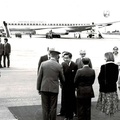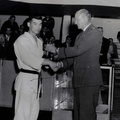Civil Rights and Asian American Movements
In fact, in the 1960s, problems arose in the Japanese community, such as drug abuse among young people and social welfare for elderly Issei who were unable to rebuild their lives after returning from the internment camps and lived in poverty. However, these issues were ignored in the Japanese community, which was supposed to be a "model minority," which only made the problems worse.
One of the social workers at the time who was tackling the problem of drug abuse among young people was Karen Ishizuka, chief curator at the Japanese American National Museum.
"We Sansei were expected to be better than anyone else, stay out of trouble, be good Americans, but our parents never explained why that was."
Most of the Issei and Nisei who were sent to the camps never spoke about their experiences, which meant that many Sansei grew up unaware of where they were born or their family history. It wasn't until college in the late 1960s that Sansei learned about the "concentration camps," as the camps are known in English.
"For the first and second generation, the internment brought such deep feelings of shame and anger that they didn't want to pass that burden on to the next generation," Karen said.
Karen, a third-generation American, only learned about the internment camps her family had been sent to in the late 1960s, when she went to college.
The 1960s was a time of change in which the civil rights movement became more active. Demonstrations were held all over the country, and life-risking movements were carried out, including the assassination of civil rights activist Malcolm X in 1965, the violent incident against demonstrators in Selma, Alabama known as "Bloody Sunday," and the assassination of Martin Luther King Jr. in 1968. As part of this movement, laws to correct discrimination were passed one after another, such as the Civil Rights Act in 1964, which prohibits discrimination on grounds such as race, religion, sex, and country of origin, the Voting Rights Act in 1965, which prohibits racial discrimination and discrimination against language minorities in voting laws, and the Fair Housing Act in 1968, which prohibits discrimination on grounds such as race, religion, sex, country of origin, physical disability, and family structure in real estate sales and rentals.
Seeing black people standing up against years of discrimination and risking their lives to demand their rights, Asian Americans are also beginning to take action regarding their own identity and rights.
"The Asian American movement was heavily inspired by the black civil rights movement and the Black Power movement that followed against racial discrimination. Our fight wasn't about 'becoming a better American than anyone else,' but that we were fighting against a white supremacist social structure. We weren't black, and we certainly weren't white, but we realized we were fighting against a common enemy," said Karen.
A famous example of cooperation is the friendship between Malcolm X and Yuri Kochiyama. After leaving the camp, Yuri started her married life in New York. While working and living with the black community in a low-income public housing complex, she became involved in the civil rights movement and became close friends with Malcolm X. However, their friendship came to an abrupt end with his assassination. Yuri ran over to support Malcolm X's head when he fell to the floor and wrote in his memorial to him, "To live in the hearts of those left behind is not to die. Therefore, Malcolm is alive!" Yuri, who also said, "To stand up and take action is to live," like her beloved Malcolm X, devoted herself to her beliefs in the civil rights movement, Asian American movement, and anti-nuclear movement until her death in 2014, and had a great influence on subsequent generations.
The reason why Asians, who were supposed to be the "model minority," became aware of this struggle by people of color was the anti-Vietnam War movement that took place in the 1950s and 1960s at the same time as the civil rights movement. Asian Americans, including Japanese Americans, were drafted into the Vietnam War without exception. For Asian Americans, while they faced racial discrimination in their own country, they were also ordered to kill Vietnamese who looked like them on the battlefield, and were sometimes called discriminatory terms for the enemy and mistaken for the enemy on the battlefield. Witnessing such injustice, they launched an anti-war movement, viewing the Vietnam War as an unreasonable war that oppressed people of color.
No matter how "good Americans" they become, Asian Americans have always been pushed to the margins of society as "foreigners." Even the term "Asian American" was not in common use until 1968, and Asian Americans were referred to as "Orientals" as if they were foreigners. "Asian American," coined by second-generation historian and civil rights activist Yuji Ichioka in 1968, is an identity of solidarity chosen by Asians who were the targets of racism and xenophobia in order to raise their voice and say that they too are Americans.
Karen recalls the moment she first came to think of herself as an Asian American: "It was a very empowering experience when we realized that we were both people of color and could be each other's strength. Through this solidarity, we became the majority for the first time, not the minority."
In the late 1960s, Asians began to move beyond stereotypes and assert their rights as Americans. At the same time, they established ethnic studies and Asian American studies departments at universities around the country, aiming to collect, preserve, research, and communicate the history of people of color, which is rarely mentioned in white American history, as American history.
Mike was one of the founding members of the UCLA Asian American Studies Center, one of the core organizations. Today, the history of Japanese immigrants to America and the Japanese Americans who have them as their ancestors undoubtedly exists as American history, and we can know it thanks to the dedication of the Sansei who tried to record history and pass it on to the next generation. And it was born in a time and space created by black people.
Supporting the Redress Movement and the Black Community
The black civil rights movement not only influenced the Asian American movement, but also paved the way for postwar immigration.
"The Civil Rights Act was passed in 1964, and the Voting Rights Act in 1965. The black community campaigned desperately to achieve these goals, and in the atmosphere created by this movement, immigration reform was passed in 1965," says Mike.
The Immigration Amendments of 1965 abolished the national immigration quotas that had been introduced by the Immigration Act of 1924. From 1924 to 1952, all immigration was prohibited, and after 1952 only a little less than 200 immigrants were allowed per year. Now, like other countries, the door to immigration to America was opened to Japan.
"Whether it's immigration legislation, the Civil Rights Act or the Fair Housing Act, we other minorities have benefited greatly from the struggles of black people," Mike said.
The civil rights movement gave birth to the Asian American movement, and the Sansei began to become aware of minority rights and interested in their own roots. There they discovered pride in their "Japanese" identity and the history of internment that the Issei and Nisei had long kept quiet about. The Sansei, who had been fighting alongside blacks and other Asians to correct racial discrimination, realized that racism was inseparable from their community. They did not view the history of internment as a stigma against their community, but as a mistake caused by racial discrimination, and launched the "Redress Movement." Redress means "to correct a mistake." This was a movement to regain the identity, civil rights, and democracy that had been lost due to the mistakes made by the country.
In 1980, the Commission on Wartime Internment and Relocation of Civilians (CWRIC) was established. In 1981, public hearings were held across the United States, where approximately 750 first and second generation Japanese who had not spoken about their internment experiences for decades testified. In 1982 and 1983, the Commission concluded that the forced removal and internment of Japanese Americans was not based on military necessity, but was an unjust policy caused by "racism," "wartime hysteria," and "mismanagement by political leaders," and recommended the payment of compensation to former internees.
In 1987, House Bill 442, a redress bill based on the recommendations of CWRIC, was debated. Ron Dellums, a black congressman elected from California, stood on the floor of the 100th Congress and began speaking about the time in 1942 when Japanese Americans were sent to internment camps.
"My house was in the middle of Wood Street in West Oakland, and on the corner there was a grocery store run by a Japanese family. A Japanese boy named Roland, who was the same age as me and worked at the store, was my best friend. Mr. Chairman, I have an unforgettable memory. It was the day an army truck came along and took my best friend away. That memory is etched deeply into the mind of six-year-old me. I will never forget the fear I saw in my best friend Roland's eyes, and the pain of having to leave my home."
"I don't want to go!" Roland shouts, and Ron shouts back, "Don't take my friends!" As an adult, Ron becomes a federal senator and calls for support for the Redress bill.
"This is compensation for the pain that thousands of Americans have had to endure simply because they happen to have yellow skin and happen to have Japanese ancestry. This black American stands with my Asian American brothers and sisters on this issue. Support this bill and let Roland know that you understand the pain in his eyes and the heartache in his heart as he was taken away screaming in a truck, not knowing if he would ever come back!"
After a long struggle, the Civil Liberties Act was signed into law in 1988 by President Ronald Reagan. This act acknowledged and apologized for the wrongdoing of the forced removal and internment of Japanese Americans, and provided for the payment of $20,000 in compensation to each surviving former internee. Redress for the internment of Japanese Americans was achieved not only because of the efforts of the Japanese American community, but also because various minorities, including blacks, understood that this was not limited to Japanese Americans, but was an issue of racial discrimination against all minorities, and joined forces to realize redress so that it would never be repeated.
*This article is reprinted from The Lighthouse (Los Angeles edition, August 1, 2020; San Diego edition, August 2020; Seattle/Portland edition, August issue).
© 2020 Masako Miki / Lighthouse






